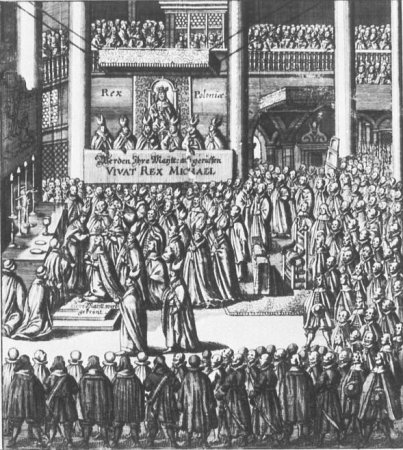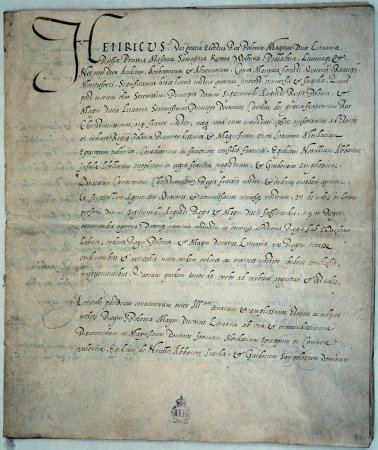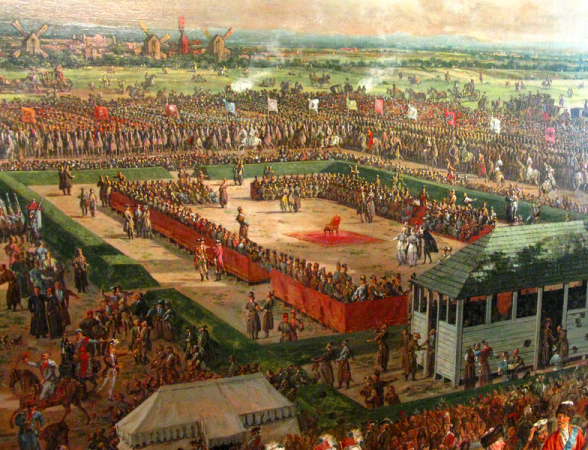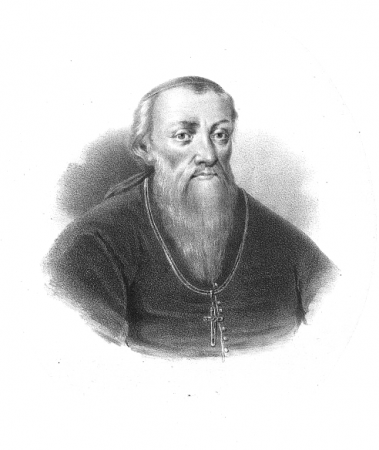Convocation Sejm
A Convocation (see Latin con "co-" and vocatio "summoning") was the first Sejm in the Polish Commonwealth to be held at the beginning of an interregnum. It was preceded by pre-selection assemblies convened by the primate, who, should an interregnum occur, assumed the function of an interrex, i.e. a head of state. In this sense, the Convocation Sejm, also convened by the primate, was the first stage in the election of a new ruler. As the first Sejm in an interregnum, a convocation Sejm was a short, 4-week event modelled on the ordinary Sejm. The primary task of the Convocation Sejm was to organize the state of interregnum in order to secure continuity of the state. This included organizing of the judicial system (approval of hood courts), armed forces for the duration of the interregnum and establishing its command, the internal administration, levying taxes, as well as legislating the law to be in force during the interregnum. Often, it provided solutions that would permanently enter into the legal order of the Polish Commonwealth. Moreover, as part of its organising function, a convocation Sejm would decide on the dates of convening the local assemblies, time and place of the election Sejm and election procedure, as well as methods and means that would protect the country from foreign interference and would allow to secure a internal peace during the interregnum. These measures were to be secured in a general confederation, which was the final act of the Sejm. The second important function of an interregnum Sejm was to represent the Polish Commonwealth abroad. Its third function, which appeared already in the first interregnum (1572-1574) and remained within the scope of its tasks, becoming more and more important with time, was the issue of making attempts to improve the political system of the Polish Commonwealth, in particular to demand rectification of errors from the predecessor's rule which were the source of exorbitance and gravamins.
The existence and principles of the Convocation Sejm during the interregnum were based on the adoption of certain legal fictions during the first two interregnum periods in the years 1572-1574 and 1574-1576. They were connected with the circumstances of the Sejm’s activities, which was a state of emergency, originated from and determined by the vacancy of the throne. The first ficticious measure was the principle of accepting the existence and functioning of a third social class which consisted of the primate acting as an interrex. The primate did not hold a full royal authority but, jointly with the senate, he substituted for the king in the performance of duties related to current state policy, convening pre-convocation assemblies and the Convocation Sejm, representing the state abroad, and controlling the administration. The second fiction was the preservation of a two-chamber structure of the Sejm, intended to emphasize that the session was of ordinary character, with the two chambers holding session mostly together.A convocation Sejm which was held as a confederation, had the possibility to adopt the constitution by a majority of votes. As a result, it could not be forced to an end. The third fiction was that the mode of proceeding of the Sejm was based, barring a few differences, on the same mechanisms as the ordinary Sejm sessions. However, certain activities performed by the king were omitted, not as unnecessary, but rather acting as if they had been performed. During an interregnum, the convocation Sejm played the role of the institution of the supreme power.
The convocation Sejm was convened for the first time during the first interregnum on 6-29 January 1573, and the last one took place in 1764 before the election of King Stanisław August Poniatowski. Convocation sessions were held in Warsaw. Convocation sessions in the years 1573, 1574, 1575, which deliberated as confederations, have established precedents for the future, which were repeated during the interregna in the years 1587, 1632, 1648, 1668.
See: W. Konopczyński, Konwokacje, in: Studia historyczne ku czci S. Kutrzeby, I, Kraków 1938, p. 247-268; J. Dzięgielewski, Sejmy elekcyjne. Elektorzy. Elekcje 1573-1674, Pułtusk 2003; E. Dubas-Urwanowicz, Koronne zjazdy szlacheckie w dwóch pierwszych bezkrólewiach po śmierci Zygmunta Augusta, Białystok 1998; Olszewski H., Sejm Rzeczypospolitej epoki oligarchii 1652 - 1763. Prawo, praktyka, teoria, programy, Poznań 1966; D. Makiłła, Sejmy w bezkrólewiu. Instytucja władzy najwyższej Rzeczypospolitej, in: Między Barokiem a Oświeceniem. Parlamentaryzm, joint paper edited by Barbara Krysztopa-Czupryńska and Jerzy Kiełbik, Olsztyn 2016, p. 17-27.





